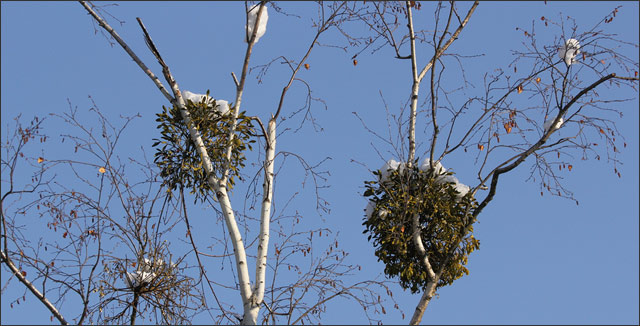The Secrets Behind the Mistletoe

Have you ever found yourself under a mistletoe and wondered what it is and how did we came to practice this strange holiday tradition that involves kissing?
Washington Irving’s words in the 1800s describes it best by saying, “young men have the privilege of kissing the girls under [mistletoe], plucking each time a berry from the bush. When the berries are all plucked the privilege ceases.”
But, why the mistletoe? Is it just another clever way for boys to steal kisses from their crushes? What does it have to do with Christmas? Let’s take a moment to step back and try to understand the mystery of the mistletoe – what is it, where did it come from, and how it came to be a holiday tradition today.
What is Mistletoe?
The unique mistletoe has qualities unlike other plants. It takes on a parasitic form as it uses other trees to grow. While the plant can grow on its own, it much prefers to attach itself to another tree by sending its roots into the trunk or branches and steals its nutrients and water. These special roots are called, haustoria.
When a bird eats the berries of mistletoe, they will fly high above the trees, and then excrement, spreading the seeds up high in the trees. The mistletoe then grows high above the shade, growing on the branches of the highest trees soaking in the sunlight allowing it to thrive.

Wild mistletoe growing in trees
Two Types of Mistletoe
There are hundreds of different species of mistletoe, but there are two different types of mistletoes. The first is called, Phoradendron flavescens and is native to North America. The second is native from Europe and is called, Viscum album. This mistletoe has green leaves and grows yellow followers and white sticky berries. These berries are considered poisonous and warnings are often put on packaging to make sure that people do not eat them.
Mistletoe Folktales
How does this strange, unromantic patristic plant become such a key role in a story surrounding kissing?
There are many different folktales and myths out there. The variety found in Europe was used with religious significance by its ancient denizens. The idea of kissing under the mistletoe is found in Celtic rituals, Scandinavian, and Norse mythology as well.
Celtic Folklore
According to the Celts in Gaul, they considered the mistletoe a scared plant to have medicinal properties and mysterious supernatural powers.
Scandinavian Folktale
In ancient Scandinavia, if you were out in the woods and happened to find yourself standing under this plant as you were encountering an enemy, you both had to lay down your arms until the following day.
Norse Folklore
Norse mythology tells of a myth that involves the goddess Frigga. In this story, the mistletoe was considered a sacred plant to Frigga, the goddess of love and the mother of Balder. Balder was the god of the summer son. One night, he had a dream in which he would die. This troubled his mother, Frigga greatly, for if he would die all life on earth would end.
Frigga went to all the other gods and asked for them not to harm him. Air, fire, water and earth and every animal and plant all agreed not to harm Balder. Loki, the god of evil was jealous of Balder and the love and power he possessed. He knew of one plant that Frigga overlooked to help keep her son safe – the mistletoe. It didn’t grow on the earth or under the earth. Loki then made an arrow tip of the mistletoe and shot it at Balder and killed him. Frigga vowed that the mistletoe would never again be used for evil only love, and all who pass under it will share a kiss of love.
The True History of the Mistletoe
Whatever story you decided to embrace, we can see a see a true historical story of kisses when taking a look at the way the mistletoe spreads its seeds and has learned to survive and thrive. This story lies in the role of the birds – that is where the real kiss of the mistletoe is found.
According to the Smithsonian, the real kiss lies in the seeds. They explain that even after passing through a bird, the seeds are so sticky that they would even stick to the bottom of the bird, its feet, and anything else when it released excrement. The seeds were so sticky that the excrement refused to fall to the ground. The bird would have to land on a branch and find a place to sit so that it could use its feet to scrape the excrement off of its feather and onto other surfaces. This is how the mistletoe finds its way to grow high on the branches of other trees.
The seeds or kisses of mistletoe are so strong and sticky that they are the perfect equation for continued growth and ability to multiply. Maybe this is why for some ancient cultures it was a sign of fertility. Whatever the idea you want to take from the mistletoe, whether myth or true, when we understand the unique beauty of this abnormal plant, we can appreciate it in a new light.
Wrapping Up
While the mistletoe is a Christmas tradition that doesn’t necessary have a clear cut origin, it’s clear that is a lot to be said about this plant. It has found its way in thousands of years of history and has made its way to modern day as a staple for holiday tradition.
Whatever story you choose to embrace, the mistletoe’s very natural existence can be a great reminder of the spirit of Christmas. It is a story of a plant that is humble enough to cling to the strength of another. It knows that it needs something else to survive. Maybe then we can see for ourselves how its very existence is a reminder of the spirit of Christmas.
Your Turn
Do you have mistletoe up in your home? What folktales have you heard of around this strange plant? Please let us know in the comments below.

